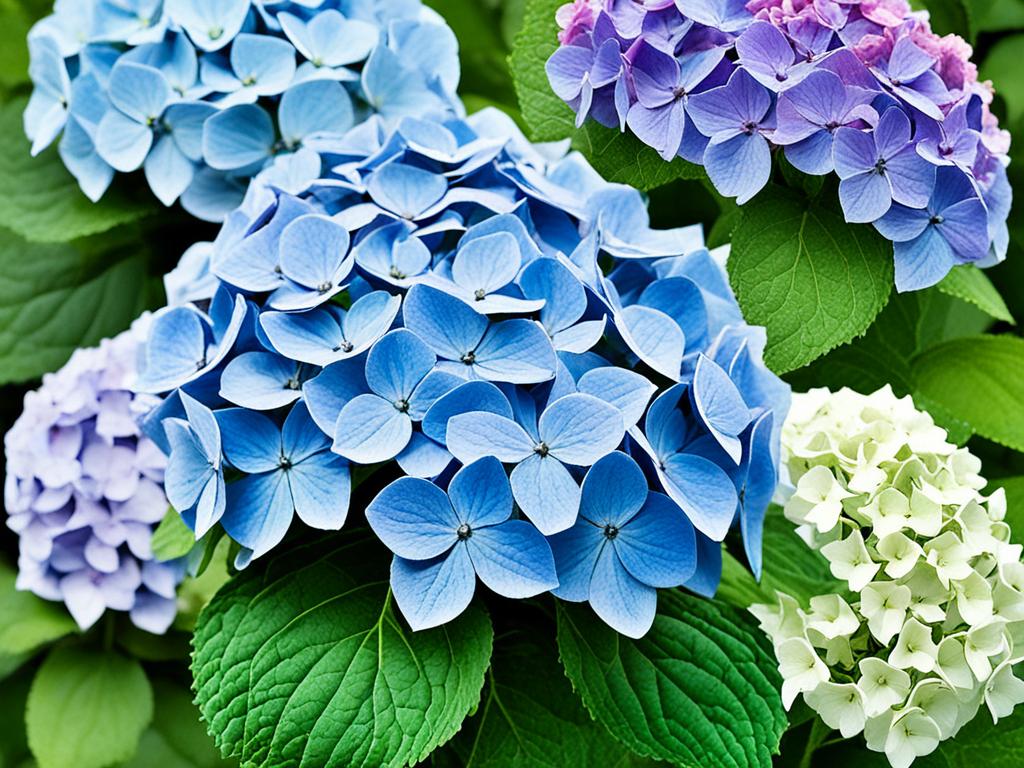I’ve always loved gardening and the many hydrangea types and their beautiful flowers. Ever thought about how big these shrubs can get? From tall climbing hydrangeas to small mountain hydrangeas, their sizes vary a lot. This guide will cover hydrangea size, what affects their growth, and the biggest sizes of popular types. It’s perfect for those planning a garden or just interested in these lovely plants.
Introduction to Hydrangea Sizes
Size is key when it comes to hydrangeas! These beautiful shrubs vary greatly in height and spread. It’s important to know how big each type can get. This knowledge is key for planning your garden or choosing the right hydrangea for your space.
Different Hydrangea Species Have Varying Mature Sizes
Hydrangeas come in all shapes and sizes, from tall climbers to small mounds. Let’s explore some popular hydrangea types and their mature sizes:
- Climbing Hydrangea (Hydrangea anomala subsp. petiolaris): Up to 40 feet tall
- Smooth Hydrangea (Hydrangea arborescens): Up to 5 feet tall
- Bigleaf Hydrangea (Hydrangea macrophylla): Average height of 6 feet
- Panicle Hydrangea (Hydrangea paniculata): Up to 15 feet tall
- Oakleaf Hydrangea (Hydrangea quercifolia): Up to 8 feet tall
- Mountain Hydrangea (Hydrangea serrata): Compact at 4 feet
Factors Affecting Hydrangea Growth and Final Size
While the type of hydrangea sets its size range, other factors can change how big your plants get. These include:
- Sunlight: Hydrangeas do well in partial shade to full sun. The amount of sunlight affects their growth.
- Water: Hydrangeas need consistent moisture and good drainage to grow well.
- Soil Conditions: The right soil pH, nutrients, and drainage are key for hydrangea size and health.
- Climate: Some hydrangeas are better suited for certain climates, ensuring they grow and stay the right size.
- Pruning: Pruning can help control the size and shape of your hydrangeas.
Knowing how different hydrangea species grow and what affects their size helps you pick the best ones for your garden or landscape.
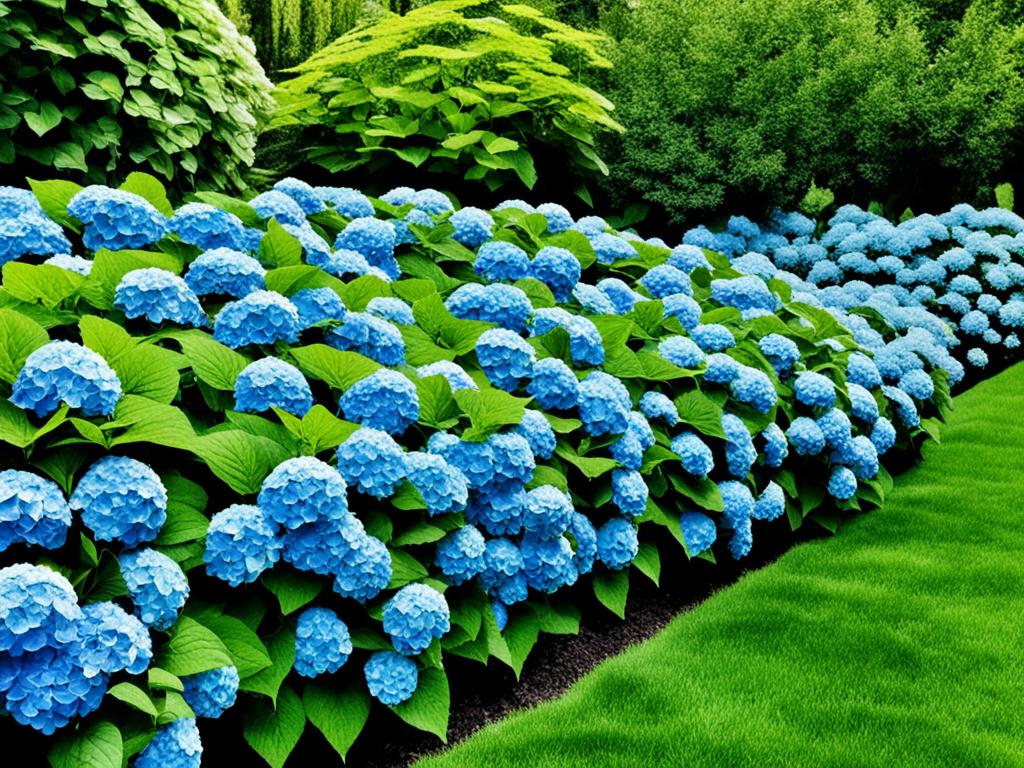
Sunlight Requirements for Optimal Hydrangea Size
Hydrangeas need the right amount of sunlight to grow well. They do best in partial sun, getting morning sun and afternoon shade. This mix of light helps them grow big and healthy.
Panicle hydrangeas love full sun and get lots of sunlight. But bigleaf hydrangeas prefer shade to avoid too much sun. Finding the right balance is key for big, healthy hydrangeas.
- Most hydrangeas need filtered light or a few hours of full sun to bloom well.
- They usually like being in partial sun, getting sun in the morning and shade in the afternoon.
- Panicle Hydrangeas do great in full sun. Varieties like Fire Light®, Limelight, Pinky Winky®, Strawberry Sundae®, and Vanilla Strawberry® are good examples.
- New types like Let’s Dance® and dwarf big leaf, Cityline®, do well in full or partial sun.
- Oakleaf hydrangeas like Alice Oakleaf and Ruby Slippers Oakleaf can handle full sun in the north but like some shade in warmer areas.
Knowing what sunlight each hydrangea type needs helps gardeners give them the best light. This way, hydrangeas grow big and show off their beautiful flowers.
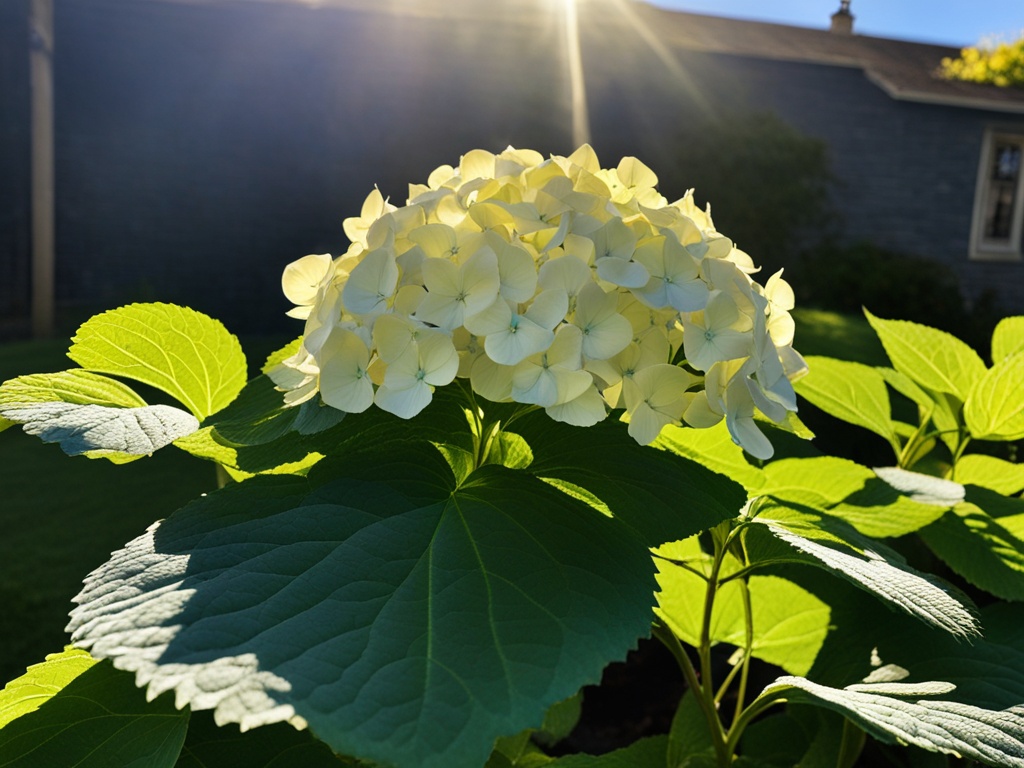
Water and Hydrangea Size
Proper watering is key for hydrangeas to grow big. These plants need about an inch of water each week, from rain or watering. Keeping the soil around the roots consistently moist is important.
Watering in the morning is best before the sun gets too high. Don’t water from above to avoid diseases. Use a slow, deep soak to let water go deep into the soil. This encourages strong roots and helps the plant grow as big as it can.
Hydrangea Watering Techniques for Healthy Growth
- Water hydrangeas at the base, not on the leaves
- Give about an inch of water each week, from rain or watering
- Water deeply, letting the soil get fully soaked
- Water in the morning to cut down on evaporation and prevent diseases
- Adjust watering based on the weather and plant size – more for big plants, less for small ones
By using these watering tips, gardeners can help their hydrangeas grow big and beautiful. Regular, right watering is crucial for hydrangeas to reach their full size.
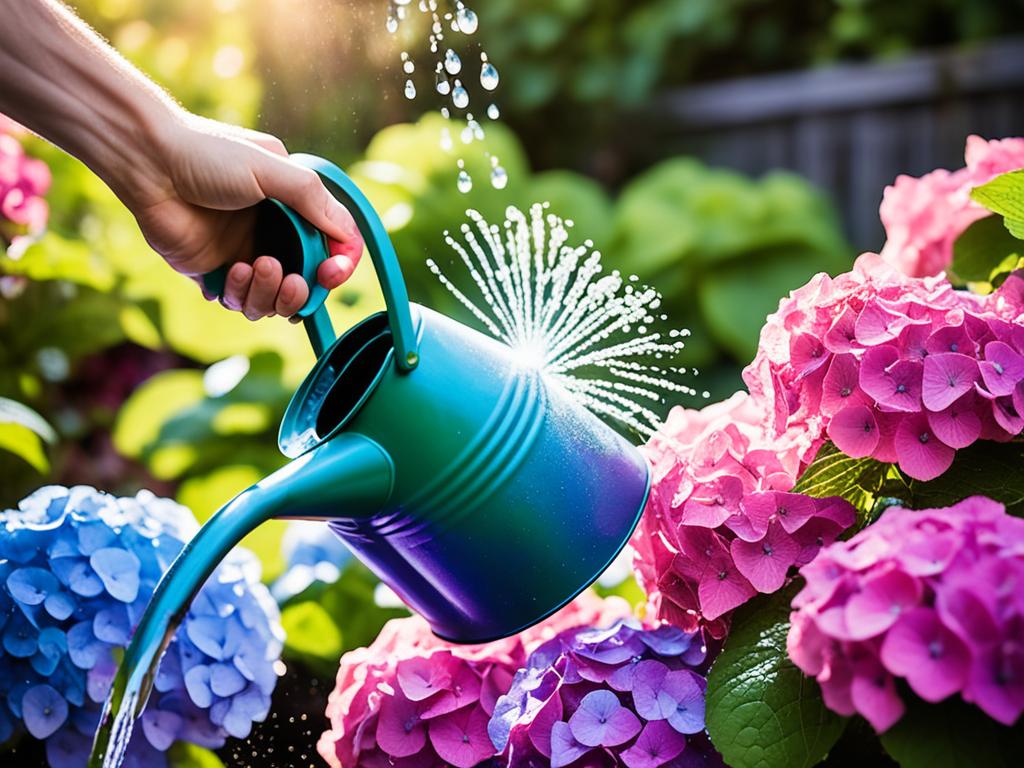
Soil Conditions and Hydrangea Size
Getting the soil right is key to your hydrangeas growing big and beautiful. They love acidic, well-draining soil full of organic matter. The soil’s pH affects flower color too. Acidic soil makes blue flowers, while alkaline soil makes pink ones.
To help your hydrangeas grow well, add compost, peat moss, or other organic stuff to the soil. This improves drainage and gives your plants the best conditions to thrive. Good soil is crucial for their healthy growth and bright flowers.
- Hydrangeas prefer acidic soil with a pH between 5.2 and 5.8 for best growth and color
- Well-draining soil is essential to prevent waterlogging and support robust root systems
- Incorporating organic matter like compost or peat moss can enrich the soil and enhance nutrient availability
| Soil Requirement | Optimal Range | Impacts |
|---|---|---|
| pH | 5.2 – 5.8 | Flower color |
| Drainage | Well-draining | Root health and growth |
| Organic Matter | High | Nutrient availability and soil structure |
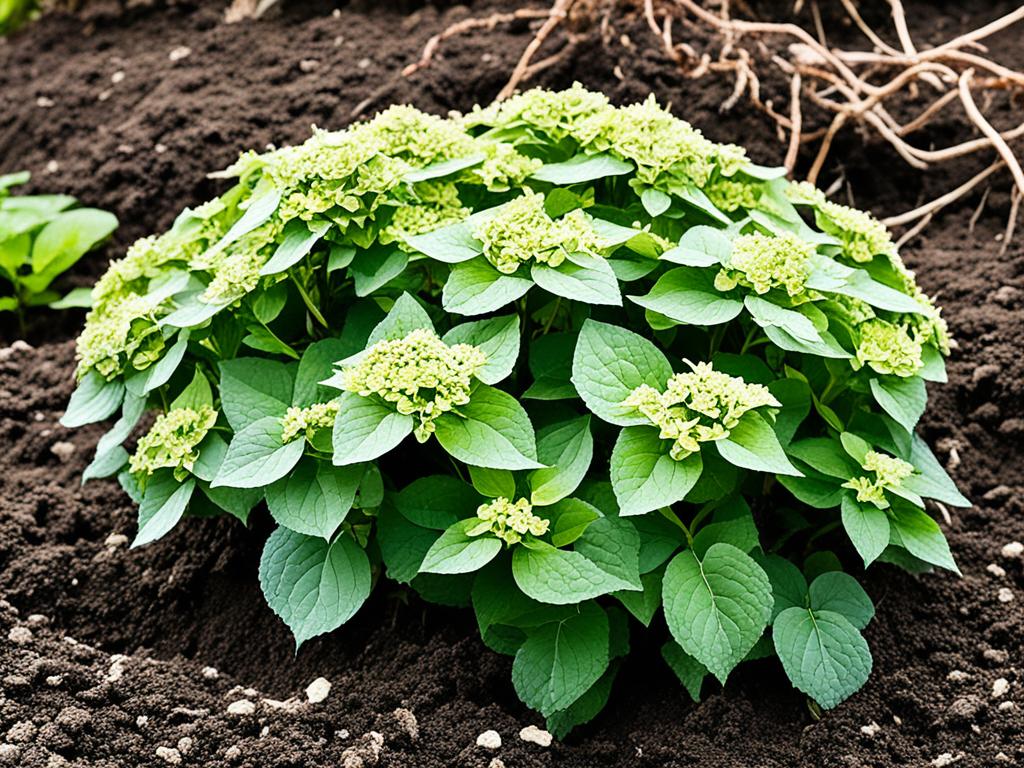
Understanding what hydrangea soil requirements are can help your plants thrive. By amending and optimizing the soil, you’re making a smart move. This small effort leads to big rewards in your garden.
Climate Zones for Growing Hydrangeas to Maximum Size
Hydrangeas are adaptable plants that do well in many climate zones. But, some areas are better for them to grow big. These plants are usually hardy in USDA Hardiness Zones 3-9. The conditions in each zone affect their size and how well they do.
The best places for big hydrangeas are in cooler zones, like Zones 3-7. These areas have the right temperatures and enough rain for hydrangeas. By picking hydrangea types that fit your local hydrangea climate zones and hydrangea hardiness zones, you can get the biggest plants in your garden.
In warmer hydrangea growing regions of Zones 8-9, hydrangeas might not get as big because of the heat and dryness. But, with the right plants and good care, gardeners in these zones can still have big hydrangeas. It’s important to pick hydrangea cold hardiness types that handle the heat and dryness well.
No matter your climate, knowing what different hydrangea types need helps you pick the best plants for your garden. Think about sunlight, water, and soil to make the best space for your hydrangeas. This way, your hydrangeas can grow big and beautiful.
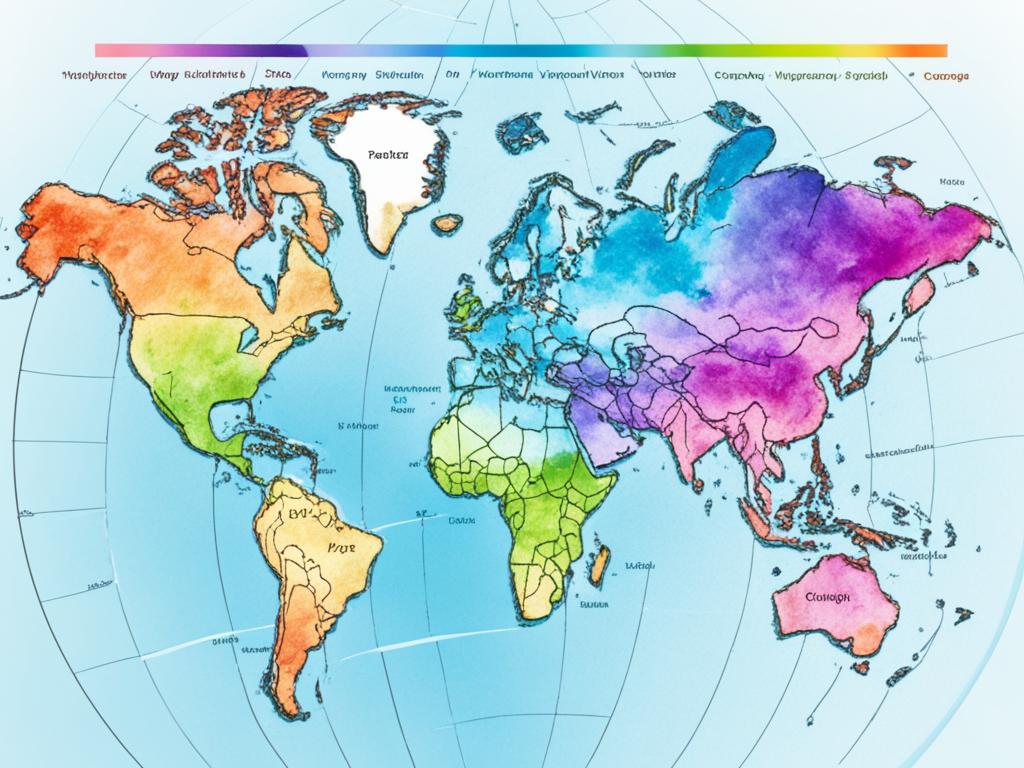
Pruning Techniques for Controlling Hydrangea Size
Proper pruning is key to keeping your hydrangeas the right size and shape. Trimming them helps them grow fuller and more vigorous. This leads to bigger flowers and a plant that’s easy to manage. The best time to prune is usually in midsummer, after the first bloom cycle.
Here are some important pruning tips for hydrangea size control:
- Make cuts just below flower clusters to promote branching and a bushier appearance.
- Remove older or damaged stems to rejuvenate the plant and stimulate new growth.
- For hydrangea varieties that bloom on new wood, such as Hydrangea paniculata, prune back to just above a fat bud in the fall, late winter, or early spring to encourage larger blooms.
- For bigleaf hydrangeas (Hydrangea macrophylla), prune after the flowers have faded and before August to allow for next year’s flowers.
- Smooth hydrangeas (Hydrangea arborescens) can benefit from hard pruning in the spring, but it’s best to let them grow for a season or two before doing so.
By using these pruning techniques, you can control the size and shape of your hydrangeas. This ensures they grow well and bloom beautifully every season.
| Hydrangea Variety | Pruning Timing | Pruning Techniques |
|---|---|---|
| Hydrangea paniculata | Fall, late winter, or spring | Prune back to just above a fat bud |
| Hydrangea macrophylla | After blooming, before August | Prune to allow for next year’s flowers |
| Hydrangea arborescens | Spring | Consider hard pruning after 1-2 seasons of growth |
Mastering hydrangea pruning lets you keep these lovely shrubs at the right size for your garden.
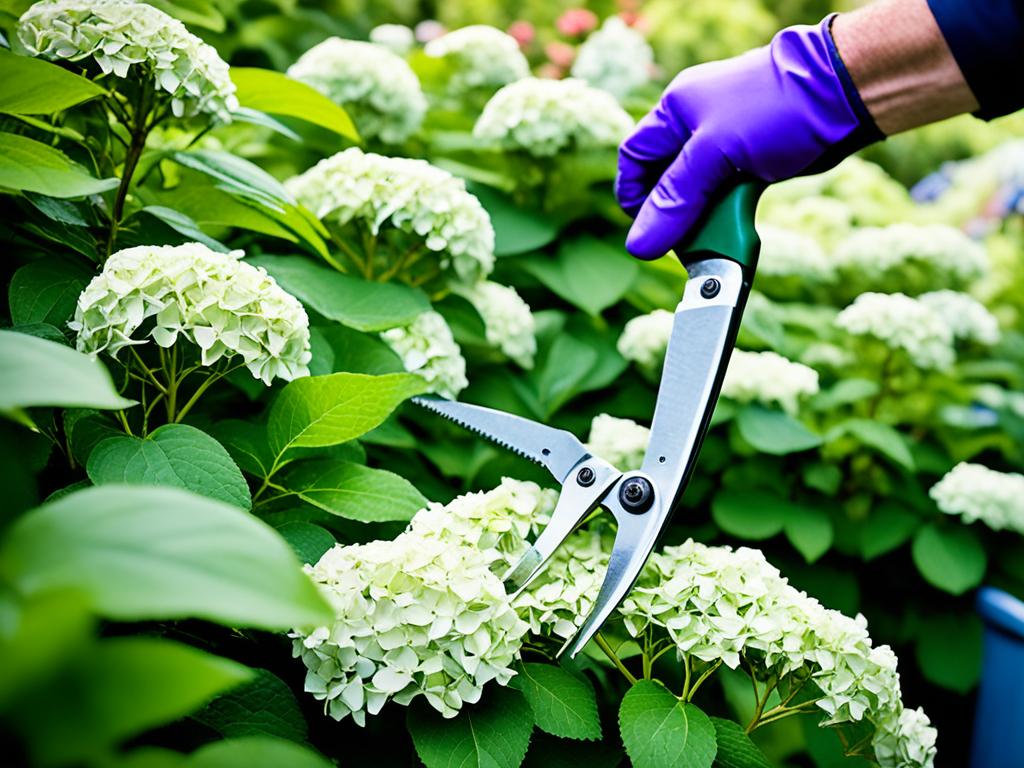
Size Guide for Popular Hydrangea Species
The size of a hydrangea depends on the species. Knowing the mature size of each type is key for choosing the right one for your garden. Let’s look at the growth of some common hydrangea species.
Climbing Hydrangeas – Up to 40 Feet Tall
Climbing hydrangeas, like Hydrangea petiolaris, can grow up to 40 feet tall with the right support. They are perfect for adding height and beauty to your garden. Use a trellis or wall to support them.
Smooth Hydrangeas – Up to 5 Feet Tall
Smooth hydrangeas, or Hydrangea arborescens, grow to about 5 feet tall. They are known for their heat tolerance and full, round shape. Varieties like the Incrediball series are popular for their growth and reliability.
| Hydrangea Variety | Mature Height | Mature Width |
|---|---|---|
| Bobo® Hydrangea | 3 feet | 3 feet |
| Candy Apple™ Hydrangea | 5 feet | 5 feet |
| Strawberry Shake™ Hydrangea | 5 feet | 5 feet |
| Angel’s Blush® Hydrangea | 12 feet | 12 feet |
| Limelight Hydrangea | 8 feet | 8 feet |
| Quick Fire® Hydrangea | 8 feet | 8 feet |
As shown, hydrangea species sizes and hydrangea growth dimensions differ a lot. From the small smooth hydrangeas to the tall climbing hydrangeas. Think about the hydrangea mature heights and hydrangea size comparisons when picking one for your garden.
How Big Do Hydrangea Grow? Bigleaf Hydrangeas
Bigleaf hydrangeas, also known as French or mophead hydrangeas, are loved for their big, beautiful flowers. They add a stunning touch to any garden. But how big do these shrubs get? Let’s look at their average size and dimensions.
Bigleaf Hydrangea Size Expectations
Bigleaf hydrangeas (Hydrangea macrophylla) usually grow to be about 6 feet tall. But, the bigleaf hydrangea height and bigleaf hydrangea size can change. This depends on the type of plant and how well it grows. Some can be more compact, staying 4-5 feet tall. Others might reach 10-12 feet tall.
The bigleaf hydrangea mature dimensions also include a spread or width similar to its height. This makes the plant look bushy and rounded. When given enough space, bigleaf hydrangeas can spread 6-10 feet wide.
| Hydrangea Variety | Typical Height | Typical Spread |
|---|---|---|
| Bigleaf Hydrangea (Hydrangea macrophylla) | 4-12 feet | 4-10 feet |
| Smooth Hydrangea (Hydrangea arborescens) | Up to 5 feet | 5-6 feet |
| Panicle Hydrangea (Hydrangea paniculata) | Up to 15 feet | 8-12 feet |
| Oakleaf Hydrangea (Hydrangea quercifolia) | Up to 8 feet | 6-8 feet |
The exact bigleaf hydrangea size and how it grows can change. This depends on things like sunlight, soil, and climate. With the right conditions, these beautiful shrubs can grow well and reach their full size.
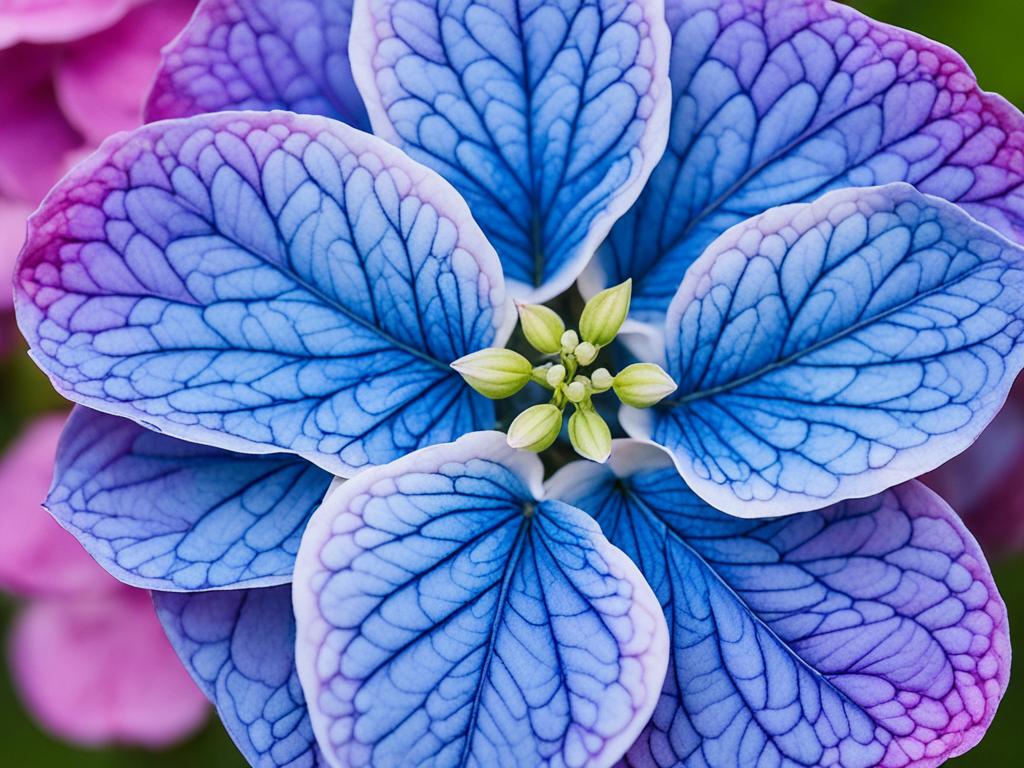
Panicle Hydrangeas – The Largest Shrub Variety
Panicle hydrangeas are the biggest type of hydrangea. They can grow up to 15 feet tall. This makes them perfect for creating privacy screens or dramatic garden features.
These plants come from eastern and southern China, Japan, Sakhalin, Taiwan, and the Kuril Islands. They have big, conical flowers that can be up to 8 inches long. These flowers start white and turn pink, red, or brown in the fall.
The Limelight variety is a favorite among gardeners. It has unique chartreuse flowers that change to pink in the fall. Angel’s Blush can grow up to 12 feet tall and wide. Quick Fire blooms early and reaches 8 feet tall and wide.
These hydrangeas do well in morning sun and afternoon shade. They like neutral to acidic, well-draining soil. They can even handle air pollution, making them great for city gardens. With their large size, panicle hydrangeas are ideal for adding drama to any garden.
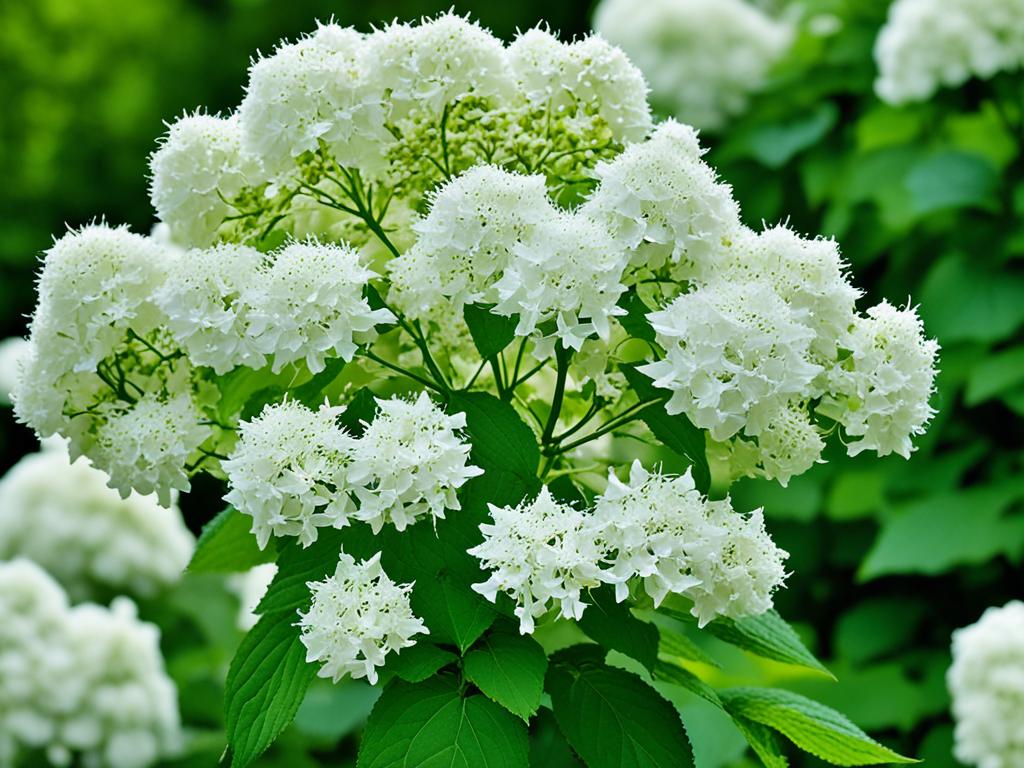
Oakleaf Hydrangeas – Up to 8 Feet Tall
Oakleaf hydrangeas stand out with their unique leaves shaped like oak leaves. These leaves turn red and purple in the fall. They can grow up to 8 feet tall, perfect for adding height and interest to gardens or property edges.
These shrubs have beautiful flower clusters in white, pink, and red. They can grow from 3 to 8 feet tall and wide. This gives gardeners many options for their space and needs.
| Oakleaf Hydrangea Variety | Height | Width |
|---|---|---|
| ‘Gatsby Moon’ | 6 to 8 feet | 6 to 8 feet |
| ‘Gatsby Gal’ | 5 to 6 feet | 5 to 6 feet |
| ‘Gatsby Pink’ | 6 to 8 feet | 6 to 8 feet |
| ‘Alice’ | 5 to 8 feet | 5 to 8 feet |
| ‘Ruby Slippers’ | 3 to 4 feet | 3 to 4 feet |
| ‘Snow Queen’ | 4 to 6 feet | 6 to 8 feet |
| ‘Pee Wee’ | 3 to 4 feet | 2 to 3 feet |
| ‘Munchkin’ | 3 to 4 feet | 3 to 4 feet |
| ‘Snowflake’ | 5 to 8 feet | 5 to 8 feet |
Oakleaf hydrangeas are versatile and stunning in any garden. They have unique foliage and blooms. They’re perfect for adding drama and texture to your landscape.
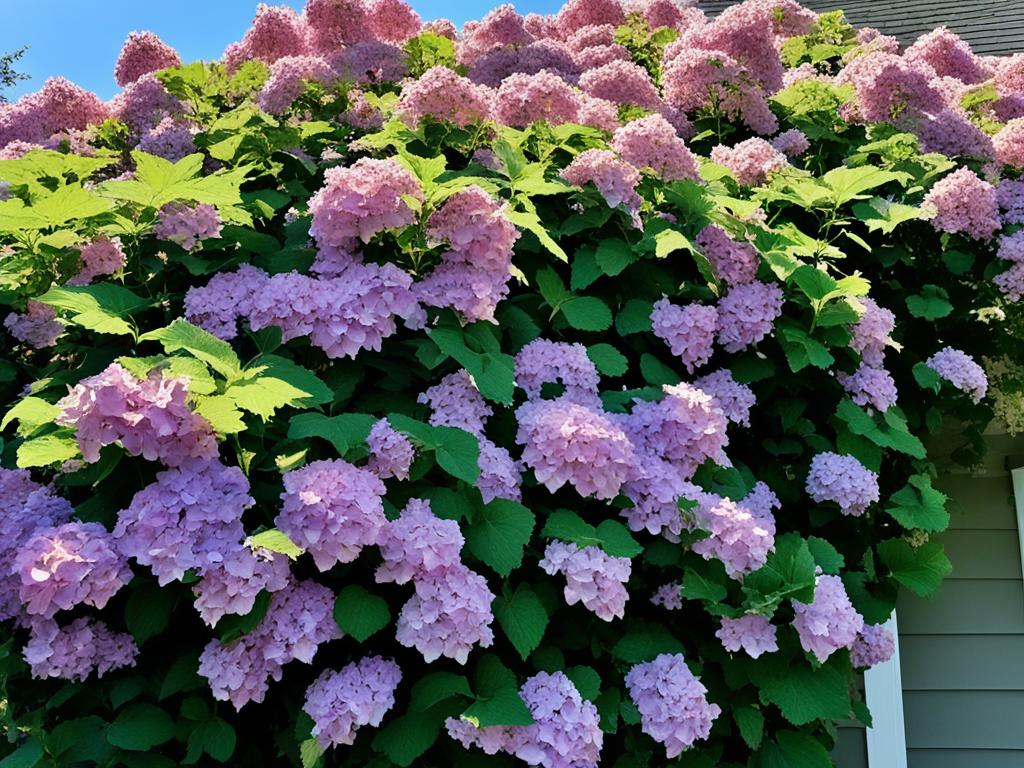
“The oakleaf hydrangea is a true standout in the garden, with its distinctive leaves and reliable, showy flowers. It’s a must-have for anyone seeking to add drama and interest to their outdoor space.”
Mountain Hydrangeas – Compact at 4 Feet
If you’re looking for a hydrangea that won’t take over your garden, the mountain hydrangea is a great choice. It grows to about 4 feet tall and wide. This makes it perfect for gardens, foundation plantings, or as a border accent.
Mountain hydrangeas, or Hydrangea serrata, have the classic lacecap flowers. They can be blue or pink, depending on the soil. These plants do well in USDA Zones 4-9, making them a good choice for many climates.
| Mountain Hydrangea Variety | Height/Spread |
|---|---|
| ‘Bluebird’ | 5 feet tall, 4 feet wide |
| ‘Shirofuji’ | 3 feet tall, 3 feet wide |
| ‘Midoriboshi Temari’ | 3-4 feet tall, 3-4 feet wide |
| ‘Grayswood’ | Up to 6 feet tall, 6 feet wide |
| ‘O Amacha Nishiki’ | 4 feet tall, 4 feet wide |
| ‘Blue Billow’ | 4 feet tall, 5 feet wide |
| Tuff Stuff™ | About 3 feet tall, 3 feet wide |
| Tiny Tuff Stuff™ | 1.5-2 feet tall, 1.5-2 feet wide |
Mountain hydrangeas are great for any garden because they’re small and come in many colors. You can pick a compact ‘Shirofuji’ or a bigger ‘Bluebird’. Either way, these shrubs will add beauty to your landscape.
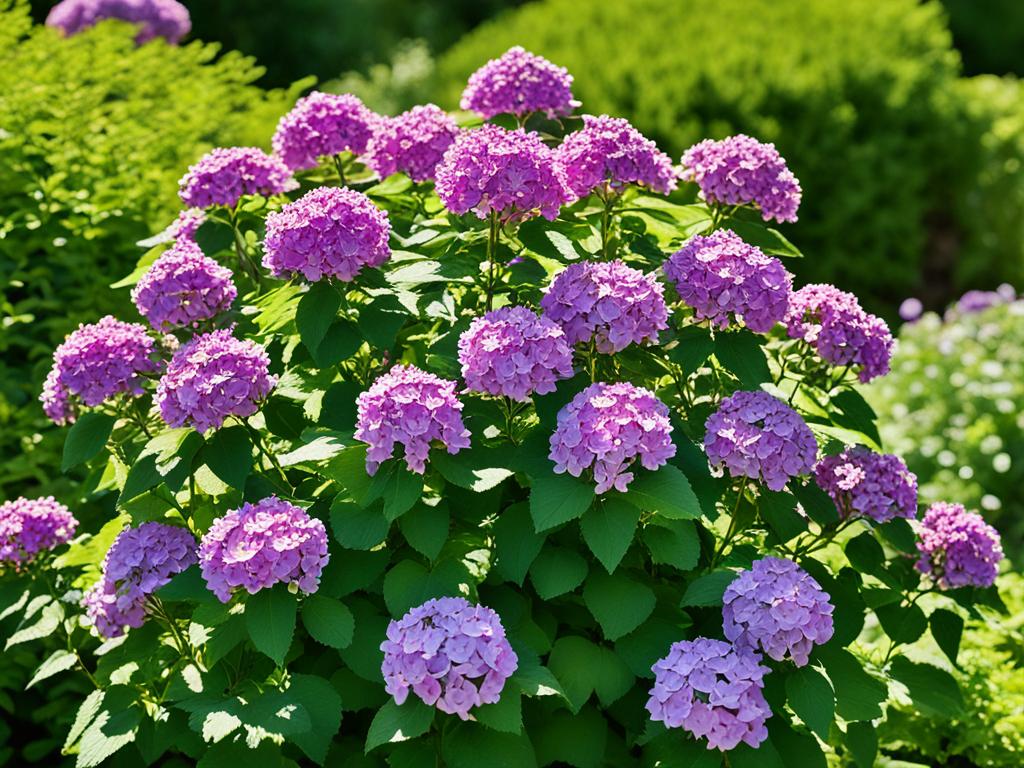
“Mountain hydrangeas are fast-growing plants, with an expectation of around 2 feet of growth annually.”
Choosing the Right Hydrangea Size for Your Space
When planning your hydrangea garden, think about the mature size of each type. Make sure you have enough room for them to grow fully. This is important for their health and looks. Smaller hydrangeas are great for containers, borders, and small spaces. Larger ones work well as focal points, privacy screens, and in big garden beds.
Choosing the right hydrangea size and hydrangea size compatibility with your space is key. Look at the growth habits and hydrangea space requirements of different species:
- Compact hydrangeas, like the Seaside Serenade® series, grow up to 3 feet tall and wide. They’re perfect for small gardens and containers.
- Climbing hydrangeas can stretch up to 80 feet, great for walls, trellises, and arbors. But, they might take 5 years to fully grow.
- Panicle hydrangeas can get as tall as 15 feet. They’re great for privacy screens and focal points in your garden.
- Bigleaf hydrangeas, about 6 feet tall, fit well in many garden spots, from borders to as standalone plants.
Plan carefully and pick the right hydrangea size for your space. This way, your hydrangeas will flourish and beautify your outdoor area for many years.
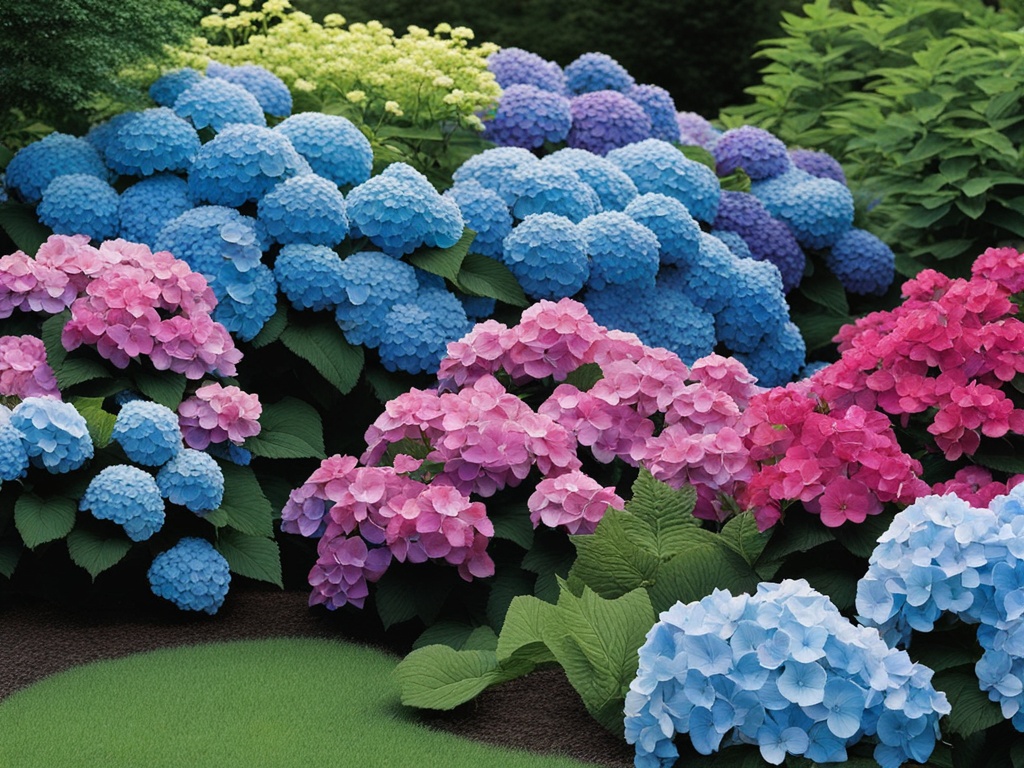
Remember, the secret to great hydrangea gardening is balancing the plant’s size with your space. With some research and planning, you can have a beautiful hydrangea display that fits your landscape perfectly.
Conclusion
Hydrangeas come in many sizes, from tall climbing hydrangeas to small mountain hydrangeas. Knowing how big each type of hydrangea will get is key to picking the right ones for your garden. Factors like sunlight, water, soil, climate, and pruning affect their growth.
Whether you like the big blooms of certain hydrangeas or prefer smaller ones, there’s a size for every garden. With good planning and care, you can enjoy these beautiful flowers for many years. They can make your garden look beautiful and show off your style.
Starting your hydrangea garden means learning how to care for these plants. With the right care, they can grow big and beautiful, adding beauty to your outdoor space. Learning about hydrangea size will help you create a garden that looks amazing and impresses your neighbors.
FAQ
What factors affect the size of hydrangeas?
Hydrangeas grow to different sizes based on sunlight, water, soil, climate, and pruning. Knowing these factors is key to getting the best size for each type of hydrangea.
How much sunlight do hydrangeas need?
Most hydrangeas like partial sun, with morning sun and afternoon shade best. The right amount of sunlight affects their size. Panicle hydrangeas do well in full sun, while bigleaf hydrangeas like more shade.
How much water do hydrangeas require?
Hydrangeas need about an inch of water each week, from rain or watering. Deep, slow watering helps them grow big and strong.
What type of soil is best for hydrangeas?
Hydrangeas do well in acidic, well-draining soil rich in organic matter. Soil pH affects flower color, with acidic soil making blue flowers and alkaline soil making pink ones.
How do climate zones impact hydrangea size?
Hydrangeas grow in USDA Hardiness Zones 3-9. Climate and conditions in each zone affect their size and how well they do. Zones 3-7 are best for growing hydrangeas big and healthy.
When is the best time to prune hydrangeas?
Prune hydrangeas in midsummer, after the first bloom. Cutting just below flower clusters and removing old or damaged stems helps control their size and shape.
How tall do different hydrangea species grow?
Hydrangea size varies by species. Climbing hydrangeas can get up to 40 feet tall, while smooth hydrangeas usually reach about 5 feet. Knowing the mature size helps pick the right hydrangea for your garden.
